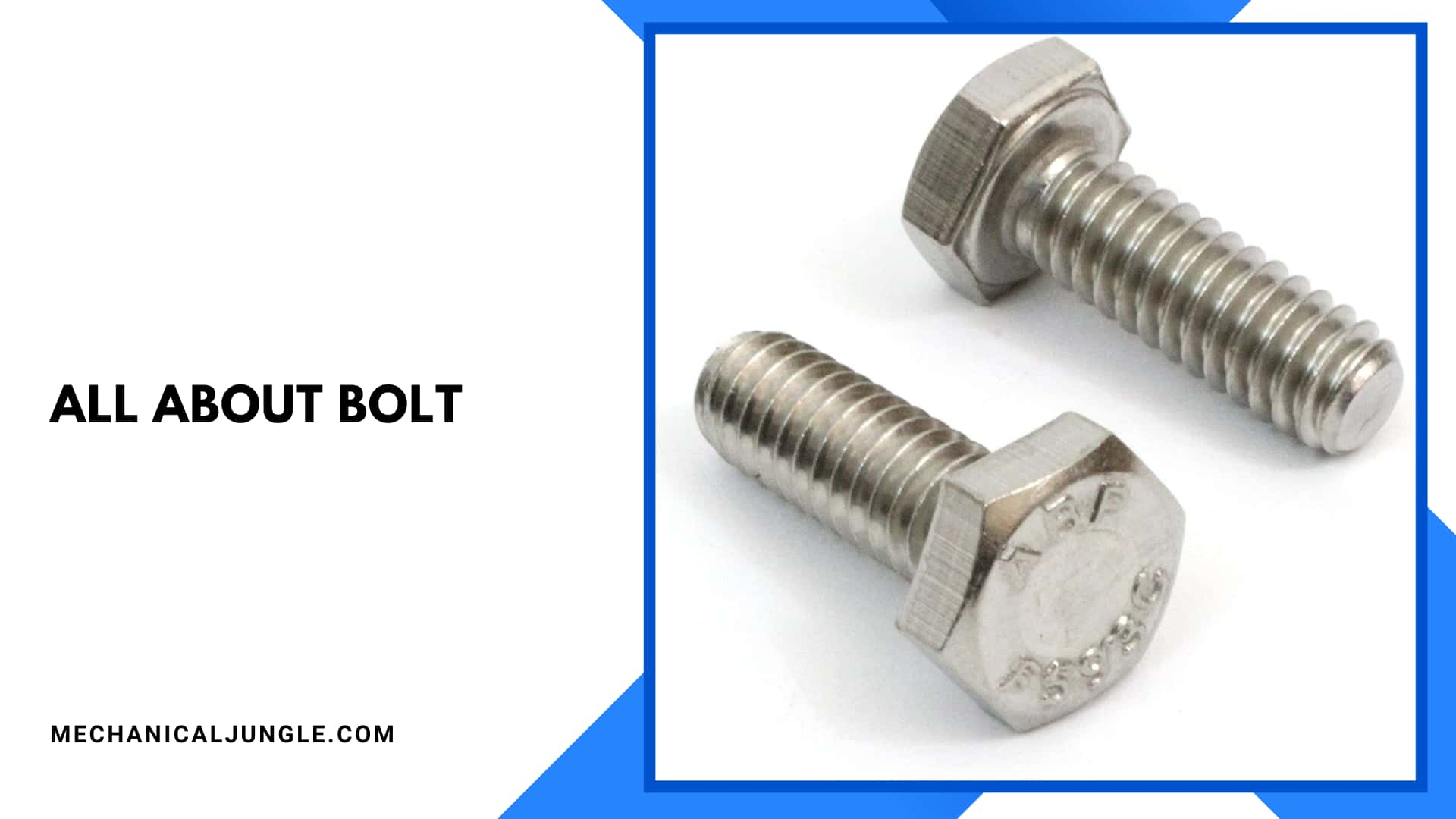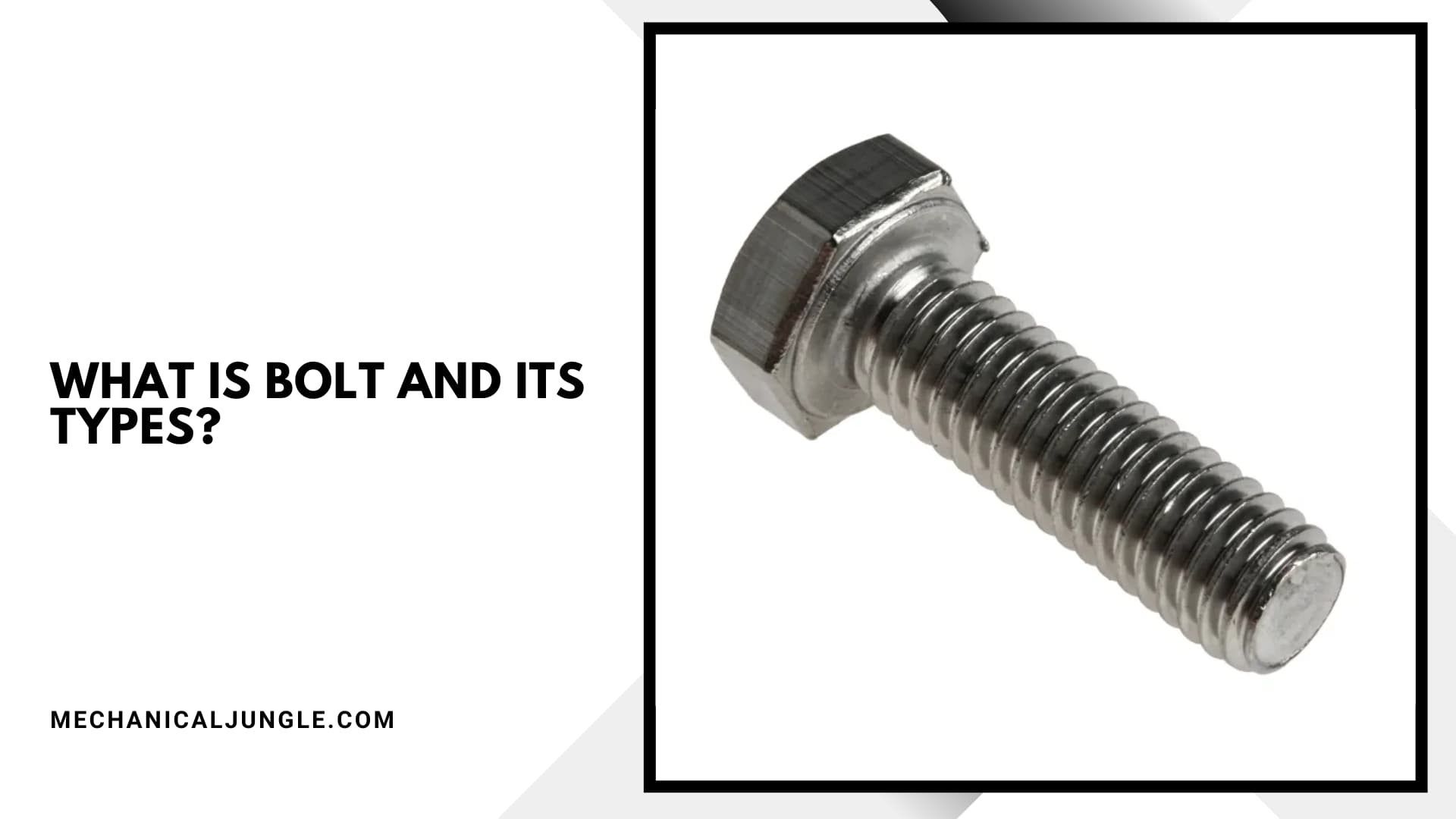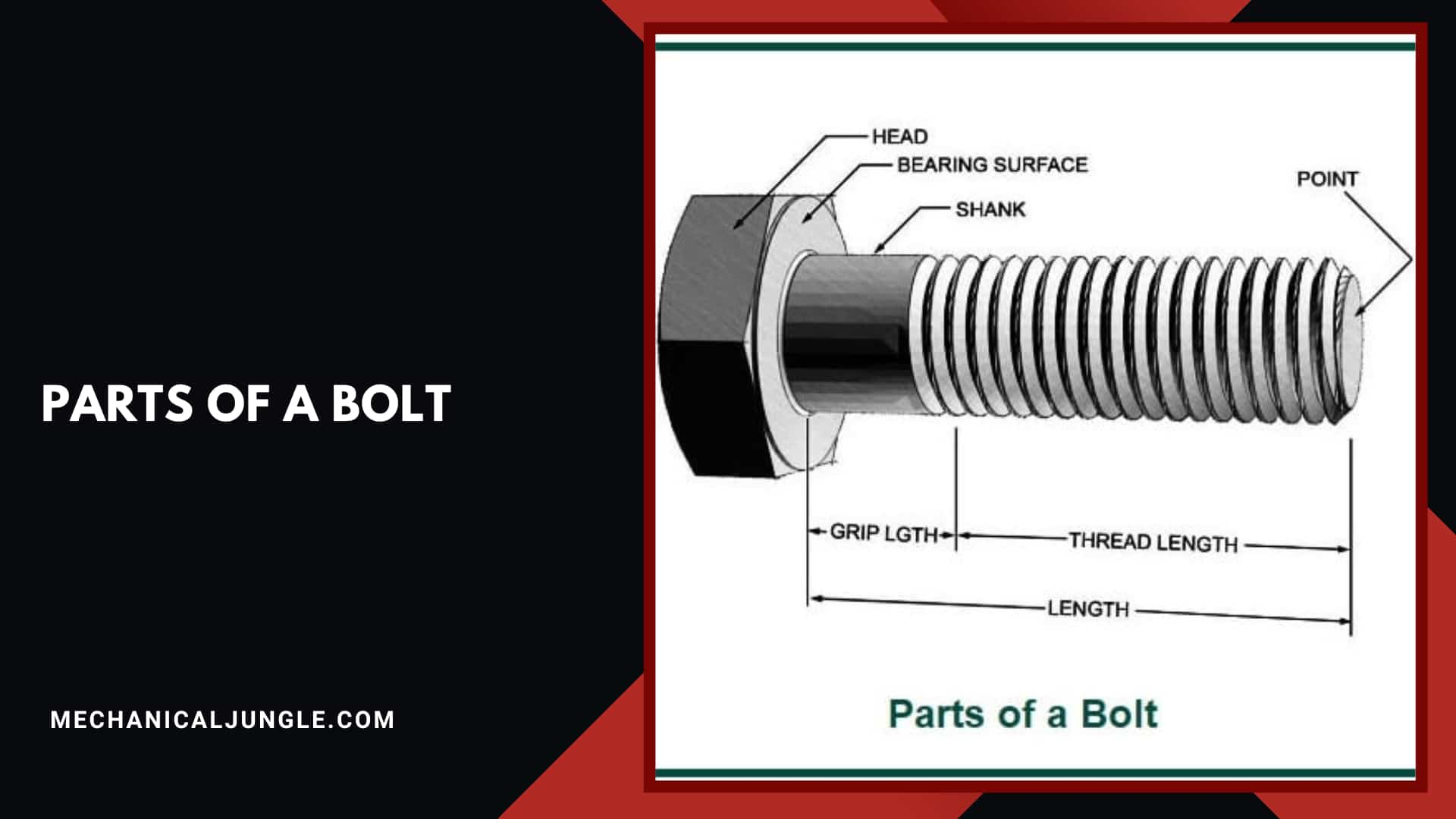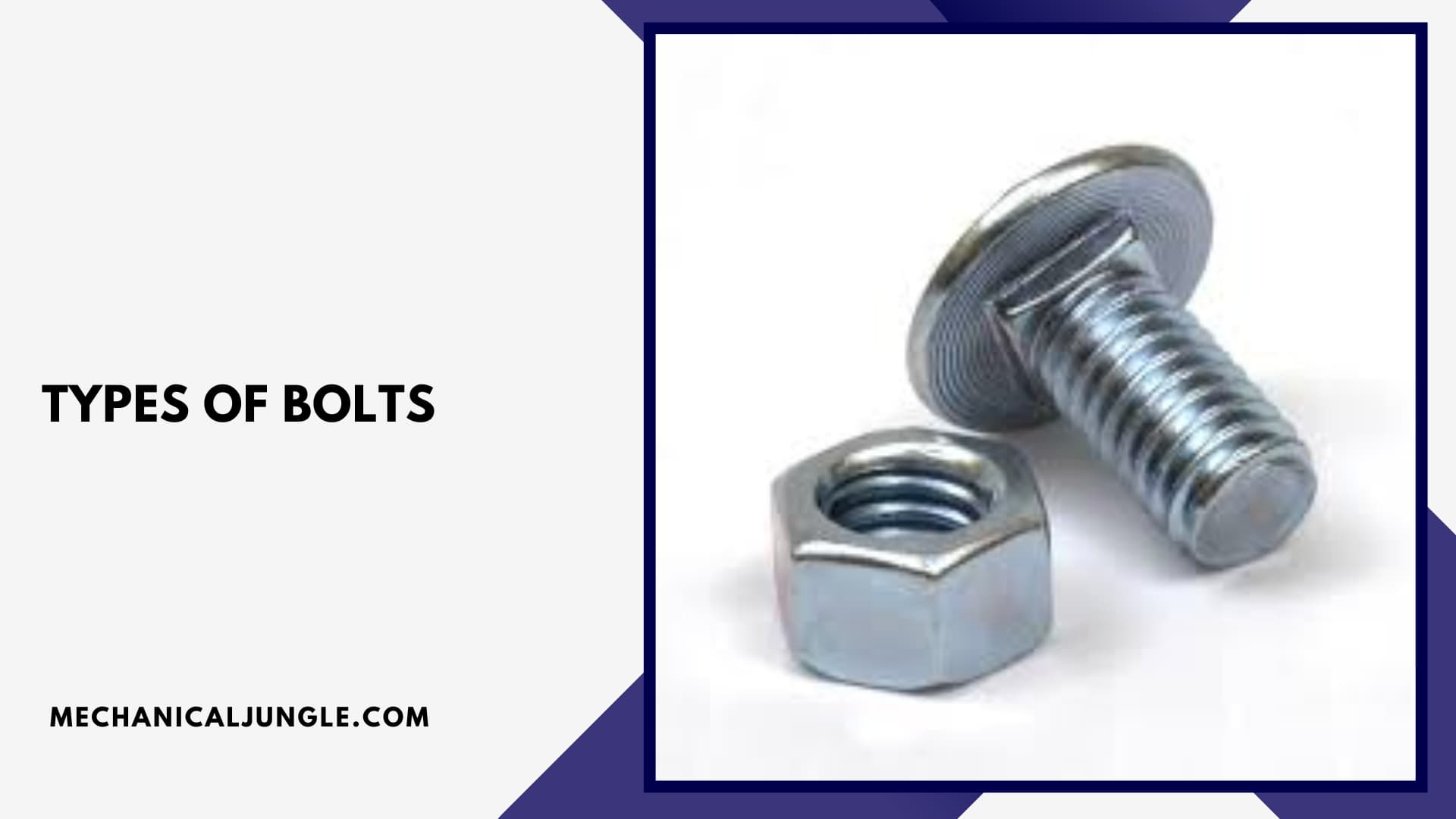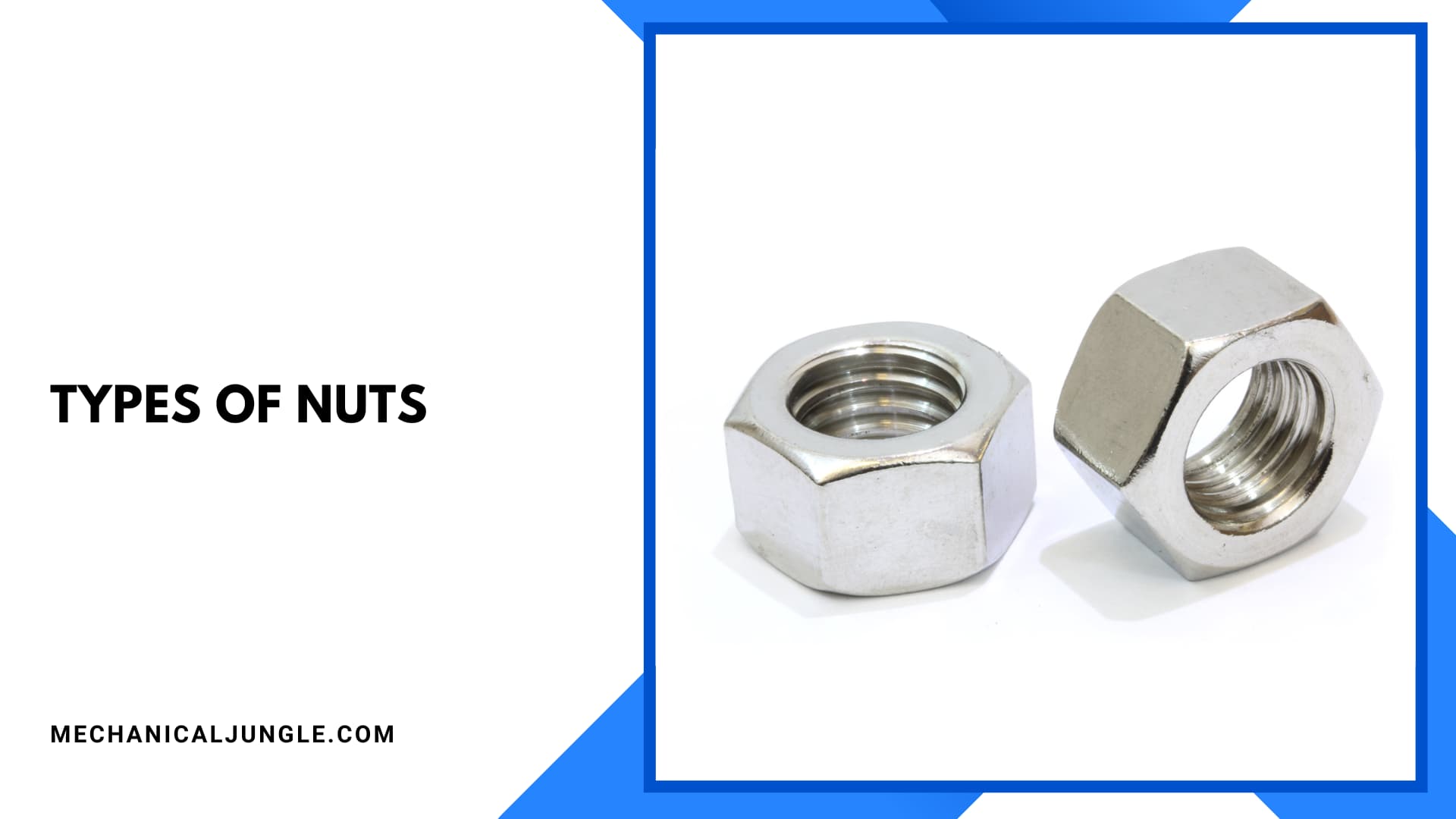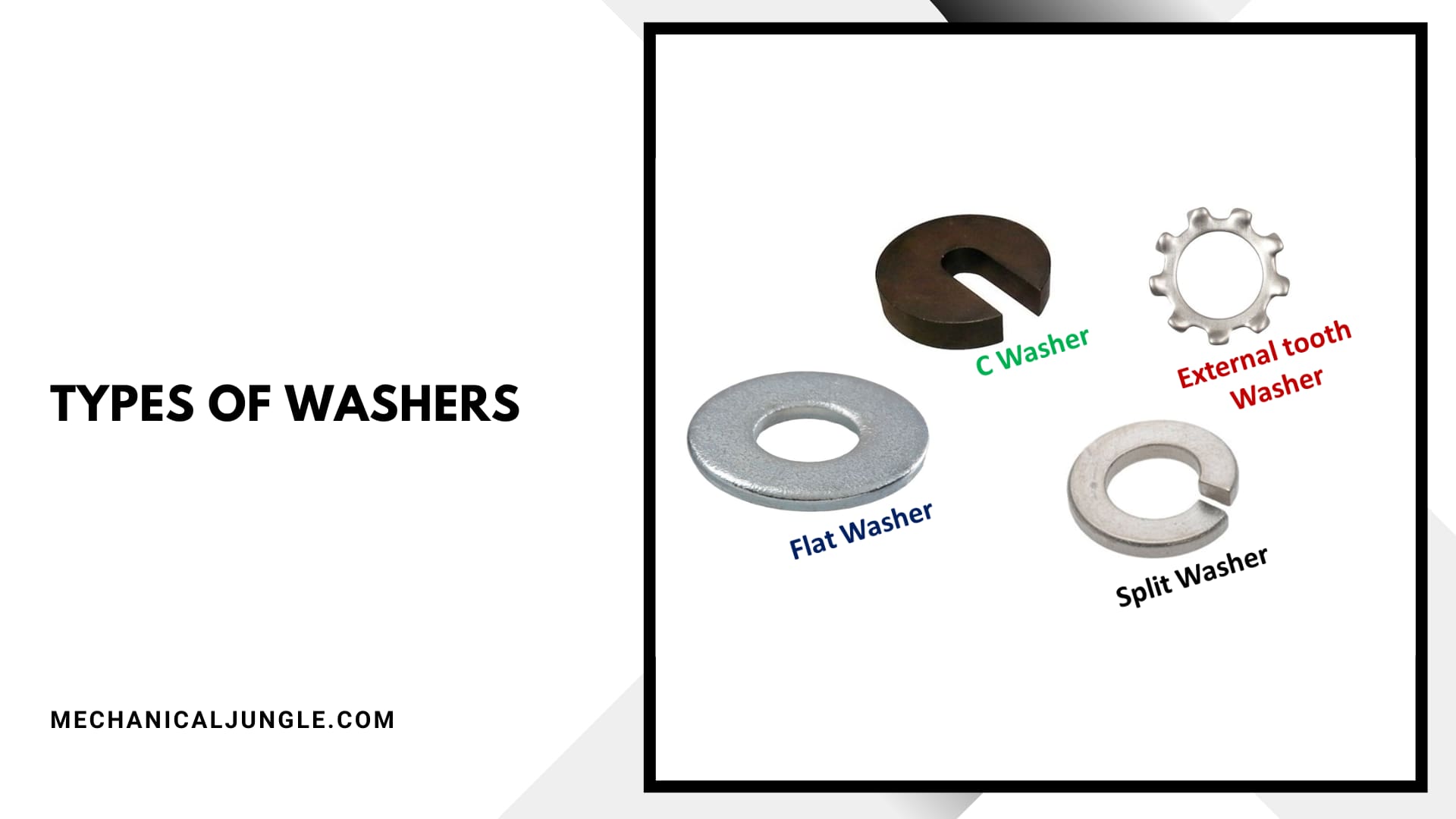Important Point
What Is Bolt and Its Types?
A bolt is a mechanical fastener with threaded shafts. The bolts are closely related to screws, which are also mechanical fasteners with threaded shafts.
This type of fastener is usually inserted through two parts, which have aligned holes. By some definitions, whether a thing is a bolt or a screw depends on how it is used.
The bolt is inserted through the parts that all have unshielded holes, & a nut is then screwed onto the bolt to provide a clamping force & prevent axial motion.
A screw my first pass through the first part with an evacuation hole, but its threads are being fastened with threads in one part. Using two numbers separated by a point, the bolts are classified according to their strength.
This grade is often stamped on the heads. The points are not decimal but act as a denominator. The first number is the ultimate tensile strengths (UTS) in MPA divided by 100, & the second numbers are the ratio of yield strength to UTS.
Common classes are 5.8, 8.8, & 10.9. For example, grades 8.8 bolt has a UTS, at which it fails, is 800 MPa and will receive 80% (640 MPa) of this value.
A bolt is a type of fastener that is used to connect two parts together. The bolts join the part non-permanently, i.e., the parts can be separated from each other using a suitable tool. Nuts are also used on the bolt to make the fastening process more effective.
Also, Read: Parts and Functions of Grinding Machine | Grinding Machine | Grinding Machine Types
Parts of a Bolt:
#1. Head
The head is the topmost part of a bolt. It serves as a gripping surface for the instrument. To tighten or loosen the bolt, a tool with the appropriate bit must hold the head. Most bolts have a head wrench-type.
In other words, a wrenching bit should be placed around the head of the bolt. However, some bolts use screw-type heads where the bit is placed in the center of the head.
Whether wrench or screw-type, all bolt heads provide a gripping surface so that the bolt can be tightened or loosened with a tool.
#2. Shank
There is a conch under the head. The Shank is the smooths part of a bolt that is devoid of threading. It is designed to prevent radial movements of the included workpiece.
Without the leg, the bolt is more likely to be loose. Some workpieces produce vibrations, while others are exposed to vibrations in the environment around them.
When the included workpiece vibrates, the bolt may loosen if it does not feature a leg. Lack of leg means that the bolt will fully extend from top to bottom (with the exception of the head). Therefore, the vibration may push the bolt backward from the included workpiece.
#3. Threading
All bolts have threading. Threading is one that allows a bolt to move in or out of the workpiece. However, most bolts do not have complete threading.
They have ahead, followed by a smooth leg and finally threading. Depending on the type of bolts, the Shank may cover a larger surface area than threading. However, all bolts have threading.
The threading of a bolt works together with the internal threading of the workpiece to join them. The bolts have external threading that is located outside their bottommost part. This allows the external threading bolt to be moved in or out of the internal threading of the workpiece.
Useful Article for You
Types of Bolts:
The Bolts are one of the most versatile structural fasteners, available in a vast array of configurations to suit different materials & strength requirements.
These fasteners differ mainly in thread specification, length, and head size, with different combinations of these characteristics resulting in bolts with different functions.
They usually require a drilled hole and a filler nut or mating portions taped for installation, and, unlike screws, they are generally not tapped.
The terminology that distinguishes between bolt types is often for inconsistent and incorrectly used screws, so it is best to select your bolt based on your project specifications rather than the exact name indicated on the supplier’s website.
- Carriage Bolt:- Carriage bolts feature a domed or countersunk head with a square underside that prevents post-installation from operating. They are often used with wood & masonry.
- Flange Bolt:- The flange bolt is a special type of hex head bolt that has an integrated flange that acts as a washer component to distribute the load more evenly.
- Hull Bolts:- Similar to carriage bolts, some hull bolts have a square-shaped counters top. Others have a domed design. These bolts are ideal for heavy-duty applications such as industrial machinery.
- Hex Head Bolt / Hex Head Cap Screw:- Characterized by their hexagonal head shape, hex head bolts are a wide range of bolts requiring installation with a wrench. They are available in many lengths & threading varieties. The hex head cap screw has a tight tolerance and is the most common hex bolt range.
- Square Head Bolts:- Like hex head bolts, square head bolts are defined by their head shape — that is, square. This head design facilitates tooling gripping while allowing easy installation.
- Socket Head Cap Screw / Allen Bolt:- The socket head cap screw has a flat chamfered top surface with smooth or curly cylindrical sides. Forged heat-treated alloy examples are high-strength fasteners intended for the most demanding mechanical applications with special alloy aggregates.
- Additional bolt types:- Other bolt types that we can custom manufacture include anchors, belts (e.g., eye, hook, J, & U), countersunk, lag, & T-handle bolts.
Types of Nuts:
The Nuts are available in a variety of shapes, sizes, materials, & thread patterns. Although your nut selection is somewhat constrained by your choice of the bolt – especially in terms of size and threading – you should still choose the size and material of the nut head that best suits your application.
- Coupling Nut:- A coupling nut is a long, cylindrical nut that connects two male threads. These components can be used to add length to an installation.
- Flange Nuts:- Similarly to flange bolts, the flange nuts are around the flange that acts as an external washer and allows for greater load distribution.
- Hex Nuts:- Hex nuts are hexagon-shaped. This nut is extremely versatile but requires a wrench for installations. The types of hexes nut we supply include finished hex, semi-finished hex, hex flange, hex jam, hex, and slated hex.
- Locknuts:- Locknuts are available in a range of sizes and are used to secure other nuts and prevent them from loosening. Types of locknuts include all-metal locknuts with top or side locking features, serrated hex flange, and nylon inserts.
- Slated Nuts:- Slated nuts are designed and manufactured such that they can form a locking mechanism with a cotters pin or a safety wire.
- Square nuts:- Square nuts are characterized by their square shape. This head size increases the surface area of the fastener and experiences a greater amount of friction, reducing the risk of loosening it.
- Wheel nuts:- Wheel nuts are a wide range of nuts used in automotive wheel applications.
- Additional nut types:- Other walnut types that we can custom manufacture include hats, castles, conicals, caps, thumbs, and feathers.
Also, Read: Parts of Benson Boiler | Working Principle of Benson Boiler | Construction of Benson Boiler
Types of Washers:
Washers are disc-shaped components that provide controlled control of overlocking and friction when used with other fasteners.
These fasteners may include dentures, indentations, and other unique structural mechanisms for use in more specific applications.
In general, they perform a variety of tasks, including loosening the fastener assembly, protecting the surface under a fastener, and evenly distributing pressure during installation and use.
Compared to nuts and bolts, washers are much less available. However, among the washer types, there are significant differences. Like the nuts, the washers should complement your selected bolt and suit your unique fastening application.
- Beveled washers:- Beveled washers are made with a slightly angled surface, allowing them to join materials that are not parallel to each other.
- Flat washers:- Flat washer is the most common type of washer. They provide larger surface areas for better load distribution. Different thicknesses are available for different types of hold strength.
- Lock washers:- Lock washers come in many sizes, such as choppers, toothed rings, conical, or springs, each designed to prevent slippages of fasteners in demanding applications. They are commonly used in an environment that experiences a high degree of vibration.
- Structural washers:- Structurals washers are one of the most heavy-duty washer options available. This thick fastener is designed to withstand the highs load pressures of construction.
Frequently Asked Questions (FAQ)
Different Types of Bolts
Basic bolts consist of a head and cylindrical body that has part of its length (or shaft) threaded (if it’s completely threaded, it’s a screw). The bolt screws into a nut that has internal threads to match the bolts.
Types of Bolts
- Anchor Bolts
- Blind Bolts
- Carriage Bolts
- Double End Bolts
- Eye Bolts
- Flange Bolts
- Hex Bolts
- Machine Bolts and Machine Screws
- Penta-Head Bolts
- Round Head Bolts
- Shoulder Bolts
- Socket Head Bolts
- Square Head Bolts
- T-Head Bolts
- U-Bolts
Bolt Head Types
- Flats Bolt Head: A counter shank head with flats top.
- Oval Bolts Head: A counter shank head with a round head top.
- Pan Bolts Head: A slightly rounded head with a short vertical side.
- Truss Bolts Head: An extra-wide head with a rounded top.
- Round Bolt Head: A dome head.
- Hex Bolts Head: A hexagonal head.
- Hex Washer Bolts Head: A hexagonal head with a round washer at the bottom.
- Slotted Hex Washer Bolts Head: A hexagonal head with a built-in washer and slot.
- Socket Cap Bolts Head: A small cylindrical head using a socket driver.
- Button Bolts Head: A low-profile round head with a socket driver.
Types of Bolts and Their Uses in Construction
In construction, various types of bolts are used depending on the specific application and requirements. Here are some commonly used bolts and their uses:
- Hex Bolts: Also known as hexagon head bolts or hex cap screws, these bolts have a hexagonal head and a threaded shaft. They are used in a wide range of construction applications, such as fastening steel structures, connecting wood components, or securing heavy machinery.
- Carriage Bolts: Carriage bolts have a round head with a square-shaped collar beneath it. They are designed to be used with a corresponding square hole or slot to prevent the bolt from rotating while tightening the nut. Carriage bolts are often used in applications where a smooth, finished appearance is desired, such as attaching decorative elements or joining wood components.
- Anchor Bolts: Anchor bolts are used to attach structural elements to concrete or masonry surfaces. They typically have a threaded end for securing a nut and washer, while the other end is embedded in the concrete. Anchor bolts are crucial for securing building columns, steel structures, equipment, and other heavy loads.
- Eye Bolts: Eye bolts have a loop or eye-shaped end instead of a traditional head. They are primarily used for lifting heavy objects, securing cables, or creating attachment points for ropes, chains, or hooks. Eye bolts are commonly found in construction projects involving rigging, hoisting, or suspension systems.
- Lag Bolts: Lag bolts, also known as lag screws, are heavy-duty screws with a hexagonal head. These bolts have coarse threads and are used for fastening wood to wood or wood to other materials, such as attaching beams, brackets, or large fixtures to wooden structures. Lag bolts require pre-drilled pilot holes to ensure proper installation.
Different Bolt Head Types and Their Advantages
Different bolt head types are designed to provide specific advantages and functionalities in construction and other industries. Here are some common bolt head types and their advantages:
- Hex Head: Hex head bolts, also known as hexagon head bolts or hex cap screws, have a six-sided head. The advantages of hex head bolts include:
- Easy to grip and tighten with a wrench or socket.
- Provides a large surface area for applying torque, allowing for higher tightening forces.
- Widely available and commonly used, making them easy to source.
- Square Head: Square head bolts have a square-shaped head with four sides. The advantages of square head bolts include:
- Provides a large contact area, reducing the risk of rounding off the head when tightening.
- Offers increased resistance to loosening due to the flat sides of the head.
- Ideal for applications where a high level of torque is required.
- Round Head: Round head bolts have a domed or rounded head with a smooth surface. The advantages of round head bolts include:
- Provides a finished and aesthetically pleasing appearance.
- Reduces the risk of injury or snagging on the bolt head.
- Suitable for applications where a smooth and flush finish is desired.
- Pan Head: Pan head bolts have a low-profile, rounded head with a flat or slightly curved top surface. The advantages of pan head bolts include:
- Provides a smooth and low-profile appearance.
- Minimizes the risk of snagging or catching on the bolt head.
- Suitable for applications where a flush or countersunk installation is required.
- Countersunk Head: Countersunk head bolts have a conical head that sits flush with or below the surface of the material when installed. The advantages of countersunk head bolts include:
- Creates a flush and smooth surface when installed, minimizing protrusions.
- Reduces the risk of catching or snagging on the bolt head.
- Commonly used in applications where a flat surface is desired or to prevent obstruction.
Bolt Material Options and Their Properties
Bolts are available in a variety of materials, each with its own properties and characteristics. The choice of bolt material depends on factors such as the application, environmental conditions, load requirements, and desired mechanical properties. Here are some common bolt material options and their properties:
- Carbon Steel: Carbon steel is a popular choice for bolts due to its affordability, availability, and general strength. Different grades of carbon steel, such as Grade 2, Grade 5, and Grade 8, offer varying levels of strength and hardness. Carbon steel bolts are susceptible to corrosion and are typically coated or plated for improved corrosion resistance.
- Alloy Steel: Alloy steel bolts are made from a variety of alloying elements, such as chromium, molybdenum, and vanadium, in addition to carbon. Alloy steel bolts offer higher tensile strength, hardness, and resistance to wear and fatigue compared to carbon steel. They are commonly used in applications that require greater strength or where specific mechanical properties are needed.
- Stainless Steel: Stainless steel bolts are known for their excellent corrosion resistance, making them suitable for applications where exposure to moisture or corrosive environments is a concern. Stainless steel contains chromium, which forms a protective oxide layer that helps prevent rusting. Common stainless steel grades used for bolts include 304 and 316, with 316 offering higher corrosion resistance, especially in marine environments.
- Titanium: Titanium bolts offer high strength-to-weight ratio, excellent corrosion resistance, and resistance to extreme temperatures. They are commonly used in aerospace, marine, and chemical industries. Titanium bolts are lightweight, non-magnetic, and biocompatible, making them suitable for applications where weight reduction, non-reactivity, and biocompatibility are crucial.
- Brass: Brass bolts are primarily used in applications that require good electrical conductivity or resistance to corrosion. Brass is an alloy of copper and zinc, providing decent strength and resistance to atmospheric corrosion. They are often used in electrical and plumbing installations, as well as decorative applications.
Top-Rated Bolt Manufacturers in the USA
- Yijin Hardware Co, Ltd.
- American Fastener Technologies.
- National Bolt & Nut Corporation.
- Apex Stainless Fasteners.
- KD FASTENERS, INC.
- USA Fastener Group Inc.
- Dale Fastener Supply.
- American Bolt & Screw Manufacturing.
Benefits of Using Specialized Bolts in Specific Applications
Using specialized bolts in specific applications can provide several benefits, including improved performance, enhanced safety, and increased efficiency. Here are some benefits of using specialized bolts:
- Enhanced Strength: Specialized bolts are often designed to provide higher strength and load-carrying capacity compared to standard bolts. They are engineered to withstand heavy loads, vibration, or extreme conditions. By using bolts with increased strength, you can ensure the structural integrity and longevity of the application.
- Improved Corrosion Resistance: In environments where corrosion is a concern, specialized bolts with corrosion-resistant coatings or made from materials like stainless steel or titanium can be used. These bolts offer better protection against rust and degradation caused by exposure to moisture, chemicals, or harsh weather conditions. Improved corrosion resistance helps prolong the lifespan of the bolts and ensures the integrity of the structure.
- Increased Safety: Specialized bolts are designed with specific safety considerations in mind. For example, in critical applications or those involving heavy loads, bolts with features like locking mechanisms or high-strength materials can provide increased safety by preventing loosening, reducing the risk of failure, or maintaining proper tension.
- Better Fatigue Resistance: In applications subject to repeated cyclic loading or vibrations, specialized bolts with improved fatigue resistance can be used. These bolts are designed to withstand the stress and prevent fatigue failure, which can occur due to repeated loading and unloading cycles. Using bolts with superior fatigue resistance helps ensure the long-term reliability of the application.
- Easy Installation and Maintenance: Some specialized bolts incorporate design features that facilitate easy installation, disassembly, or maintenance. For example, bolts with quick-release mechanisms, captive washers, or ergonomic designs can save time and effort during installation or when access is limited. Such features can improve the efficiency of assembly, disassembly, and maintenance processes.
What Is a Bolt?
A bolt is a type of fastener that is used to join or secure two or more objects together. It consists of a threaded shaft with a head at one end and a threaded portion at the other. Bolts are typically paired with nuts, which are threaded onto the bolt to provide the necessary clamping force.
The main components of a bolt include:
- Head: The head is the enlarged or shaped end of the bolt that provides a surface for applying torque during installation or removal. It can have various shapes, such as hexagonal (hex head), square (square head), round (round head), or others.
- Shank: The shank is the long, cylindrical portion of the bolt between the head and the threaded portion. It is typically unthreaded and provides the main structural strength of the bolt.
- Threaded Portion: The threaded portion is the section of the bolt that contains spiral grooves called threads. The threads enable the bolt to be screwed into a corresponding threaded hole or engage with a nut to create a secure connection.
- Nut: A nut is a separate component that is threaded onto the bolt to provide clamping force when tightened. It is typically used in conjunction with a bolt to secure two or more objects together.
Types of Nuts and Bolts
There are various types of nuts and bolts available, each designed for specific applications and requirements. Here are some common types of nuts and bolts:
Nuts:
- Hex Nut: Hex nuts, also known as hexagonal nuts, are the most widely used type of nut. They have six flat sides and an internally threaded hole to mate with bolts or threaded rods. Hex nuts are available in different grades and materials to match the corresponding bolts.
- Nyloc Nut: Nyloc nuts, or nylon lock nuts, have a nylon insert inside the threaded hole. The nylon insert provides a locking feature that helps prevent the nut from loosening due to vibration or other factors. Nyloc nuts are commonly used in applications where reliability and resistance to loosening are essential.
- Wing Nut: Wing nuts have two large wings protruding from the sides, allowing for easy hand tightening and loosening without the need for tools. They are often used in applications that require frequent adjustments or quick assembly and disassembly.
- Square Nut: Square nuts have a square shape with four flat sides and an internally threaded hole. They are commonly used in applications where a standard hex nut may rotate when tightening or loosening, such as when securing a bolt into a square hole or slot.
- Flange Nut: Flange nuts have a wide circular flange at one end that acts as a washer. The flange provides a larger bearing surface, which helps distribute the load and prevent damage to the material being fastened. Flange nuts are often used in applications where increased load-bearing capacity and vibration resistance are required.
Bolts:
- Hex Bolt: Hex bolts, also known as hexagon head bolts or hex cap screws, have a threaded shaft and a hexagonal head. They are used in a wide range of applications and can be paired with hex nuts or used in combination with threaded holes.
- Carriage Bolt: Carriage bolts have a smooth, rounded head with a square-shaped collar beneath it. The square collar prevents the bolt from rotating when tightened, making them suitable for applications where a smooth finish is desired or where the bolt must be installed from one side only.
- Anchor Bolt: Anchor bolts are designed to be embedded in concrete or masonry structures. They typically have a threaded end that protrudes above the surface, allowing for the attachment of structural elements or equipment.
- Eye Bolt: Eye bolts have a loop or eye-shaped end instead of a traditional bolt head. They are used for applications that require a secure point of attachment for ropes, cables, or chains, such as lifting or rigging operations.
- U-Bolt: U-bolts have a U-shaped design with threaded arms on each end. They are commonly used for securing pipes, conduits, or other cylindrical objects to a supporting structure.
Bolt Parts
A bolt consists of several key parts that work together to provide a secure and reliable fastening. The main parts of a bolt include:
- Head: The head is the enlarged or shaped end of the bolt that provides a surface for applying torque during installation or removal. It can have various shapes, such as hexagonal (hex head), square (square head), round (round head), or others.
- Shank: The shank is the long, cylindrical portion of the bolt between the head and the threaded portion. It is typically unthreaded and provides the main structural strength of the bolt.
- Threads: The threads are spiral grooves cut into the bolt’s shaft. They allow the bolt to be screwed into a corresponding threaded hole or engage with a nut. Threads are essential for creating a secure and tight connection.
- Threaded Portion: The threaded portion is the section of the bolt that contains the threaded grooves. It extends from the end of the shank to the point where the threads end. The length of the threaded portion can vary depending on the specific application.
- Shank Diameter: The shank diameter refers to the thickness or diameter of the unthreaded portion of the bolt. It determines the strength and load-carrying capacity of the bolt.
- Point: The point is the tapered or pointed end of the bolt that aids in aligning and guiding the bolt during installation. It can be sharp or rounded, depending on the application and the material being fastened.
- Tip: The tip is the end of the bolt opposite to the head. It is typically flat or rounded, allowing for easy insertion and preventing damage to the material being fastened.
Bolt Mechanical
When discussing bolts, the term “bolt mechanical” is not a commonly used term or phrase. However, it is possible that you are referring to the mechanical properties and characteristics of bolts. Here are some key mechanical aspects related to bolts:
- Tensile Strength: Tensile strength refers to the maximum amount of tensile or pulling force that a bolt can withstand without breaking. It is an important property that determines the bolt’s ability to resist applied loads and prevent failure.
- Yield Strength: Yield strength is the amount of stress or load at which a bolt undergoes permanent deformation. It represents the maximum stress the bolt can endure without experiencing plastic deformation or permanent elongation.
- Hardness: Bolt hardness refers to its resistance to indentation or deformation. It is typically measured on the Rockwell hardness scale. Higher hardness values indicate increased resistance to wear and deformation.
- Fatigue Strength: Fatigue strength represents a bolt’s resistance to failure under cyclic loading or repeated stress. Bolts that experience fluctuating loads or vibrations should have sufficient fatigue strength to resist fatigue crack growth and avoid failure.
- Ductility: Ductility is the ability of a bolt to deform plastically without fracturing. Bolts with good ductility can undergo elongation and deformation without breaking, making them more forgiving under extreme loads or irregular loading conditions.
Types of Fasteners
Fasteners are hardware devices used to join or secure two or more objects together. They come in various forms, each suited for specific applications and requirements. Here are some common types of fasteners:
- Screws: Screws have a threaded shaft with a slotted, Phillips, or Torx drive at the head. They are turned into a threaded hole using a screwdriver or a compatible driver bit. Screws are versatile and come in different types, including wood screws, machine screws, self-tapping screws, and sheet metal screws.
- Bolts: Bolts are similar to screws but typically require a nut to secure them in place. They have a threaded shaft and a head that can be hexagonal, square, round, or specialized for specific applications. Bolts are commonly used in construction, machinery, and automotive industries.
- Nuts: Nuts are internally threaded fasteners that mate with bolts or threaded rods. They come in various types, including hex nuts, wing nuts, square nuts, and flange nuts. Nuts are used in combination with bolts to create a secure and adjustable connection.
- Washers: Washers are thin, flat discs with a hole in the center. They are placed under the head of a fastener or between the nut and the surface being fastened. Washers help distribute the load, prevent damage to the material, and provide a smoother surface for tightening.
- Rivets: Rivets are permanent fasteners that consist of a solid cylindrical shaft with a head on one end. They are inserted through aligned holes in the materials being joined and then deformed or “set” to create a secure connection. Rivets are commonly used in structural applications and for joining metal sheets or components.
Types of Bolts in Steel Structures
The two types of bolts commonly used in steel construction include high strength structural steel, and A307 bolts (common bolts). Structural steel bolts are subcategorised into A325 (Group A) and A490 (Group B) and are high strength.
What Are Bolts Used For?
Bolts are used to fasten and assemble parts from within aligned unthreaded holes, typically with the use of a matching nut. Bolts primarily consist of a shaft and a bolt head. The unthreaded portion of the bolt shaft is called the shank, while the threaded portion is the bolt thread.
How Many Types of Bolts Are There?
Some bolt types include hex head bolts, square head bolts, u bolts, and eye bolts. Some nut types include coupling nuts, flange nuts, square nuts, and cap nuts. This guide will tell you about more than 30 different types of bolts and nuts and washers, as well as some of their applications.
Like this post? Share it with your friends!
Suggested Read –
- Broach Tool
- Material Fasteners
- Adjustable Angle Plate
- Types of Dial Indicators
- Domestic Electrolux Refrigerator | Different Components of Domestic Electrolux Refrigerator
- Types of Angle Plates | Box Angle Plate of Angle Plate | Swivel Angle Plates of Angle Plate | Cast Iron T-Slotted Angle Plate of Angle Plate
- What Is Wilson-Hartnell Governor? | Wilson Hartnell Governor | Construction of Wilson Hartnell Governor | Working of Wilson Hartnell Governor
- Cochran Boiler | Cochran Boiler Working | Working Principle of Cochran Boiler | Applications of Cochran Boiler | Advantages & Disadvantages of Cochran Boiler
- What Is Cupola Furnace? | Cupola Furnace Design । Cupola Construction | Purpose of Cupola | Working Principle of Cupola Furnace: | Advantages of Cupola Furnace | Disadvantages of Cupola Furnace | Applications of Cupola Furnace
